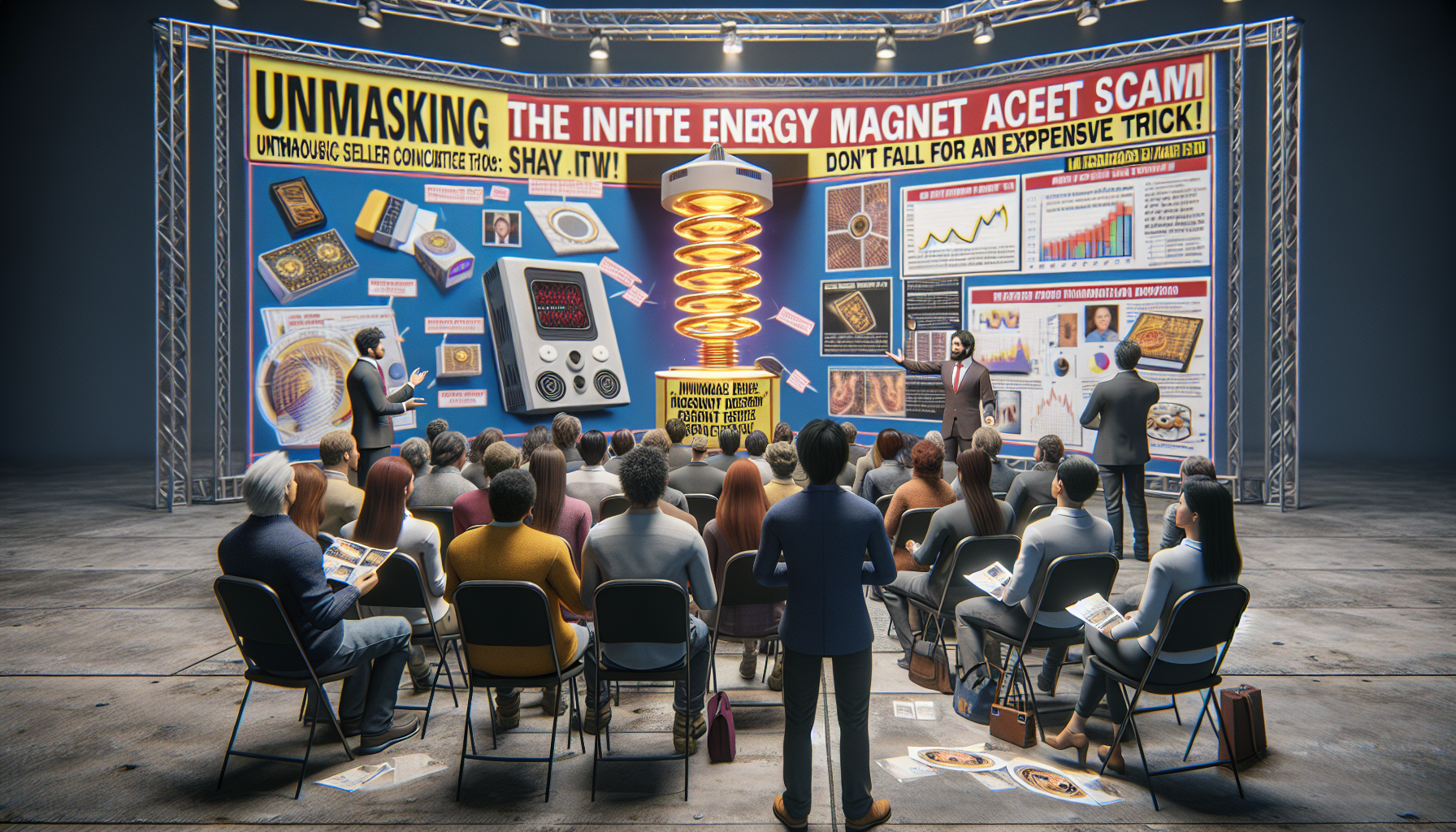In an age where innovation and technology promise to transform every aspect of our lives, from how we communicate to how we power our homes, it’s easy to get swept up in the excitement of the latest breakthroughs. Yet, this excitement can also make us vulnerable to schemes that prey on our hopes and desires for a better, more sustainable future. Among these schemes, the so-called “infinite energy magnet” scam has emerged as a particularly insidious threat, luring countless individuals with the tantalizing promise of endless, free energy. 🌟 But as the old saying goes, if something sounds too good to be true, it probably is. In this article, we will pull back the curtain on the infinite energy magnet scam, exposing the mechanisms of deceit that fuel it and equipping you with the knowledge to protect yourself from falling victim to this costly fraud.
Imagine a world where you never have to pay another electricity bill again, where your home is powered entirely by a device that generates endless energy without any fuel. It’s a vision that appeals not only to our wallets but also to our growing environmental consciousness. The infinite energy magnet claims to deliver just that—a revolutionary technology that defies the laws of physics and promises a greener, cheaper future. However, beneath the surface of these grand promises lies a web of deception spun by con artists looking to exploit our dreams and our ignorance. In this blog post, we will dissect how this scam operates, who is behind it, and why it persists despite numerous warnings from scientists and engineers.
We will delve into the psychological tactics used by scammers to gain your trust and manipulate your emotions. From carefully crafted testimonials and slick marketing campaigns to pseudo-scientific jargon that sounds legitimate, these fraudsters are skilled at creating an illusion of credibility. We’ll also explore the social dynamics that allow such scams to spread, including the role of online communities and word-of-mouth in lending an air of legitimacy to the otherwise dubious claims. Understanding these tactics is the first step in safeguarding yourself and your loved ones from falling prey to these scams.
Finally, we’ll equip you with practical advice on how to identify and report such fraudulent schemes. Knowledge is your best defense, and by educating yourself about the red flags and warning signs, you can make informed decisions and protect your finances. Moreover, we’ll provide insights into legitimate advancements in renewable energy that are worth your attention and investment, so you can channel your desire for sustainable living into truly impactful actions. Join us as we unmask the infinite energy magnet scam and empower you to make smarter, safer choices in the ever-evolving landscape of energy technology. ⚡
The Rise of the Infinite Energy Magnet Scam
The allure of infinite energy has fascinated humanity for centuries. Imagine a world where energy is unlimited, clean, and virtually free. This dream, while captivating, has led to the rise of numerous scams promising miraculous energy solutions. Among them, the so-called “Infinite Energy Magnet” scam has become increasingly prevalent. With claims of harnessing magnetic forces to generate endless energy, these fraudulent schemes prey on the hope and financial desperation of individuals seeking alternative energy sources.
The inception of this scam can be traced back to the early 2000s, coinciding with the global shift towards renewable energy solutions. As traditional fossil fuels became synonymous with environmental degradation and climate change, consumers worldwide began seeking cleaner, more sustainable energy sources. Scammers, capitalizing on this demand, devised products that supposedly exploited magnetic fields to produce energy without any external input. However, the science behind these claims is fundamentally flawed.
Despite advancements in magnetic technologies, including their use in certain types of generators and motors, the idea of generating energy from magnets alone contradicts the laws of thermodynamics. Specifically, the first law, which states that energy cannot be created or destroyed, only transformed from one form to another, debunks the possibility of creating energy from nothing. Yet, the Infinite Energy Magnet scam cleverly skirts around these scientific principles by employing pseudo-scientific jargon and convincing demonstrations designed to deceive even the most discerning of individuals.
Understanding the Mechanics of the Scam
At its core, the Infinite Energy Magnet scam relies on a combination of technical-sounding language and visual trickery. Scammers typically present their products through slick marketing campaigns, often featuring charismatic salespeople who exude confidence and authority. These campaigns are designed to lend credibility to the product, making potential victims believe that they are investing in a groundbreaking technology.
A common tactic employed by these scammers is the demonstration of a “working” prototype. These prototypes often feature intricate setups with visible moving parts, LEDs, and other electronic components. The setup is designed to create the illusion that the device is generating its own energy. However, upon closer inspection, these demonstrations often involve hidden power sources or clever sleight-of-hand techniques that deceive the audience. In many cases, magnets are arranged in such a way that they appear to be powering a device, when in reality, they are simply part of a cleverly engineered setup that uses external energy sources.
Moreover, these scams often include testimonials from supposed “satisfied customers” who claim to have experienced drastic reductions in their energy bills. However, these testimonials are typically fabricated or exaggerated, and those featured in them are often actors or individuals financially compensated to endorse the product. The goal is to create a false sense of community and shared success, prompting more individuals to invest in the scam.
Spotting the Red Flags
Identifying an Infinite Energy Magnet scam involves recognizing certain red flags commonly associated with fraudulent schemes. Firstly, the promise of “free energy” itself should be a significant warning sign. As mentioned earlier, generating energy from magnets alone is scientifically implausible, making any claims to this effect dubious at best. Additionally, scams often feature limited-time offers or exclusive deals, pressuring individuals to make quick decisions without thorough research.
Another red flag is the lack of verifiable scientific backing. Legitimate energy solutions undergo rigorous testing and are backed by peer-reviewed research published in reputable journals. If a product claims groundbreaking results without any scientific evidence, it is likely a scam. Furthermore, the absence of detailed technical specifications or an overly simplistic explanation of how the product works should raise suspicion. Genuine technological innovations are accompanied by comprehensive documentation and technical support.
Finally, a common trait of these scams is the use of dubious marketing tactics. These may include overly enthusiastic language, exaggerated claims, and an emphasis on secrecy or exclusivity. Scammers often attempt to create a sense of urgency, urging potential victims to invest before the opportunity is lost. This is a deliberate strategy to prevent individuals from taking the time to thoroughly evaluate the legitimacy of the product.
Protecting Yourself from Energy Scams
Preventing oneself from falling victim to an energy scam requires vigilance and informed skepticism. One of the most effective defenses is education. Familiarizing oneself with the basics of energy generation and the scientific principles governing it can help individuals critically assess the claims made by these scams. Additionally, conducting independent research and consulting experts in the field can provide valuable insights into the feasibility of purported energy solutions.
Moreover, potential investors should seek out reviews and testimonials from credible sources. Websites, forums, and consumer protection agencies often provide detailed analyses and warnings about scams. Engaging with these communities can help individuals identify common scam tactics and avoid falling prey to them. Additionally, cross-referencing claims with reliable scientific sources can reveal inconsistencies or outright falsehoods.
To better understand the landscape of energy solutions, it is helpful to compare legitimate technologies with those often associated with scams. The table below highlights key differences:
| Feature | Legitimate Energy Solutions | Scam Energy Solutions |
|---|---|---|
| Scientific Backing | Supported by peer-reviewed research and credible scientific evidence. | Rely on pseudo-scientific claims and lack verifiable evidence. |
| Transparency | Offer detailed technical specifications and transparent processes. | Provide vague explanations and lack comprehensive documentation. |
| Market Presence | Recognized and utilized by reputable organizations and institutions. | Often unknown with no legitimate industry endorsements. |
| Consumer Reviews | Generally positive feedback from credible sources. | Mixed or fabricated testimonials with no credible reviews. |
In evaluating energy solutions, it is essential to remain vigilant and informed. By understanding the characteristics of legitimate technologies and recognizing the signs of a scam, individuals can make informed decisions and avoid falling victim to fraudulent schemes.
To gain further insight into how these scams operate, watch this informative video that explores the intricacies of energy fraud. 🎥
Conclusion
Certainly! Below is a comprehensive conclusion tailored to your article on the Infinite Energy Magnet Scam:
—
In conclusion, the Infinite Energy Magnet Scam is a prime example of how alluring promises can sometimes lead us astray, especially when they touch on desires as universal as affordable and limitless energy. This article has explored the various facets of this fraudulent scheme, starting with its too-good-to-be-true promises of infinite energy and massive cost savings. It delved into the science, or lack thereof, behind these claims, emphasizing the importance of understanding fundamental laws of physics that defy such possibilities.
We’ve also highlighted the typical red flags associated with scams of this nature: lack of scientific validation, reliance on anecdotal evidence, and aggressive sales tactics. These warning signs are crucial for consumers to recognize, as they empower individuals to make informed decisions and protect their investments. Furthermore, the testimonials and “success stories” often employed by such schemes are frequently fabricated or exaggerated to deceive potential buyers.
Moreover, the article has outlined the broader implications of falling for scams like this—beyond financial loss, they can result in diminished trust in legitimate renewable energy innovations, which are essential in our global quest for sustainable solutions. By recognizing the difference between genuine advancements and deceitful scams, we can contribute positively to the renewable energy movement.
The significance of this topic cannot be overstated. In an era where sustainability and clean energy are at the forefront of global priorities, being informed and cautious about where we place our trust and resources is vital. This scam not only exploits individuals financially but also diverts attention and resources away from real solutions that require our focus and support.
To ensure that you, your friends, and family do not fall victim to similar schemes, it’s important to remain vigilant and educate others about these fraudulent activities. Share this article with your network, encourage conversations about the potential and limits of new technologies, and foster a community that values critical thinking and skepticism when faced with extraordinary claims. By spreading awareness, we collectively build a defense against deceitful practices that prey on our hopes and aspirations for a better, cleaner future.
Lastly, I urge you to apply the insights gained from this article to other areas of your life where skepticism and critical evaluation are required. Whether it’s evaluating a new investment opportunity, a cutting-edge technology, or a groundbreaking health supplement, the principles of due diligence and research apply universally.
For those interested in diving deeper into the science and realities of renewable energy, resources like the U.S. Department of Energy (https://www.energy.gov) and the International Renewable Energy Agency (https://www.irena.org) offer valuable insights and credible information on sustainable energy solutions.
Let’s continue to strive for a future where innovation thrives on honesty and integrity. Remember, the key to progress lies not in magical solutions, but in informed and collective action. Your voice is powerful—use it to spread knowledge and empower others to make well-informed decisions. 🌟
—
Feel free to adapt and customize this conclusion to better fit the overall tone and style of your article!

Toni Santos is a visual storyteller and conceptual archivist whose work explores the curious, often poetic ruins of pseudoscience and obsolete theories. With a reverence for forgotten frameworks and fantastical logic, Toni illuminates the imaginative spaces where science once drifted into myth, speculation, and symbolic belief.
His creative path is rooted in a fascination with the fringe — from phrenology maps to ether diagrams, hollow earth charts to animal magnetism illustrations. Each visual Toni creates or curates is an invitation to reexamine the strange beauty of discarded knowledge — not as failure, but as cultural reflection, as art born from our eternal desire to explain the unexplainable.
Blending visual design with historical inquiry, Toni gives new life to lost diagrams, metaphysical charts, and antique engravings that once shaped worldviews. His work occupies the liminal zone between fact and fiction, where obsolete models still pulse with philosophical resonance and forgotten charm.
As the mind behind Vizovex, Toni shares illustrated essays, curated collections, and visual reinterpretations that invite others to explore the aesthetic and symbolic value of outdated theories. His goal is not to validate, but to remember — to view these speculative systems as relics of human creativity, vulnerability, and yearning.
His work is a tribute to:
The elegance of error in the evolution of knowledge
The symbolic artistry of discarded explanations
The blurred lines between belief, observation, and imagination
Whether you’re a collector of curious ideas, a lover of forgotten diagrams, or someone drawn to the strange scaffolding of old worldviews, Toni opens a portal to a time when the universe was still full of ghosts, humors, and cosmic fluids — one chart, one symbol, one discredited wonder at a time.





